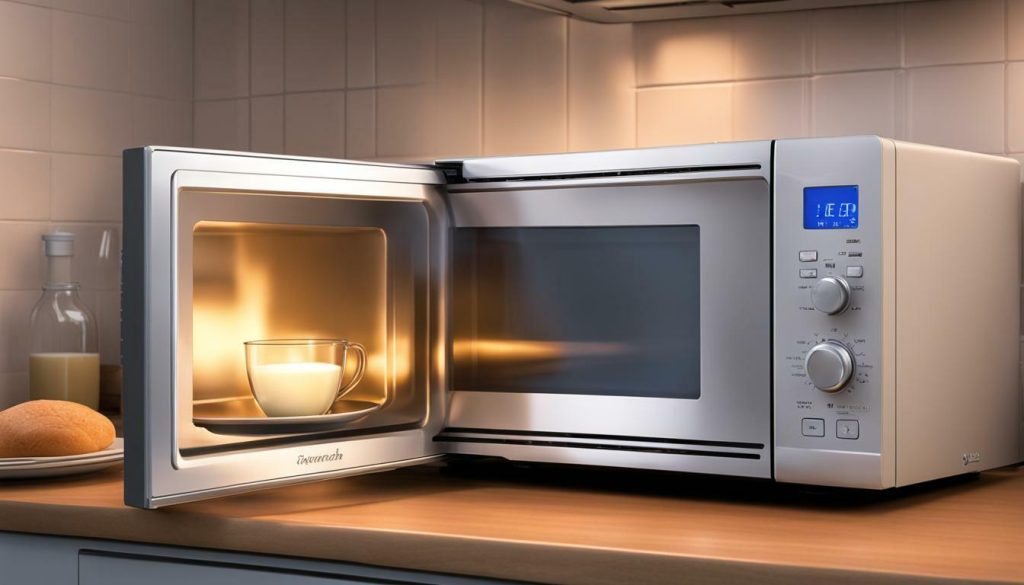
Many parents wonder if it is safe to reheat breast milk for their babies. In this section, we will explore the best practices and guidelines for reheating breast milk.
Reheating breast milk is a common practice, but there are guidelines to follow to ensure safety and quality. Breast milk can be thawed overnight in the refrigerator or by using cool running water. It should be gently heated on the stovetop or using warm running water, and never heated directly on the stovetop or in the microwave.
The milk should be gently swirled before feeding to redistribute the cream layer. Breast milk can be stored in the refrigerator for up to 5 days and in the freezer for up to one year. It’s generally recommended to only reheat breast milk once or twice, and leftover milk should be used within 2 hours if it has been warmed. Thawed breast milk should not be refrozen.
It’s important to check the temperature of the milk by shaking a few drops on the wrist. Breast milk can also be used for other purposes such as soothing skin irritation, adding to bathwater, or making personalized jewelry.
Key Takeaways:
- Thaw breast milk overnight in the refrigerator or using cool running water.
- Gently heat breast milk on the stovetop or using warm running water.
- Do not heat breast milk directly on the stovetop or in the microwave.
- Swirl breast milk before feeding to redistribute the cream layer.
- Store breast milk in the refrigerator for up to 5 days or in the freezer for up to one year.
Thawing Breast Milk: Proper Techniques for Reheating
Before reheating breast milk, it is important to properly thaw it. Let’s discuss the best techniques for thawing breast milk and the proper way to reheat it.
Thawing breast milk can be done in two ways: overnight in the refrigerator or using cool running water. To thaw it overnight, simply place the frozen breast milk in the refrigerator and allow it to thaw slowly. This method ensures that the milk remains at a safe temperature throughout the thawing process.
If you need to thaw breast milk quickly, you can use the cool running water method. Fill a clean bowl or container with cool water and place the breast milk bag or bottle in it. Make sure the container is securely sealed to prevent any water from entering. Change the water every 30 minutes until the milk is thawed. Avoid using warm or hot water, as it may cause the milk to lose some of its beneficial properties.
Once the breast milk is thawed, it should be gently heated before feeding. This can be done by using the stovetop or warm running water. Never heat breast milk directly on the stovetop or in the microwave, as it can cause hot spots and destroy important nutrients. Gently swirl the milk before feeding to redistribute the cream layer, ensuring that your baby gets all the necessary nutrients.
| Thawing Method | Time Required |
|---|---|
| Refrigerator Thawing | Approximately 12 hours |
| Cool Running Water Thawing | Approximately 30 minutes |
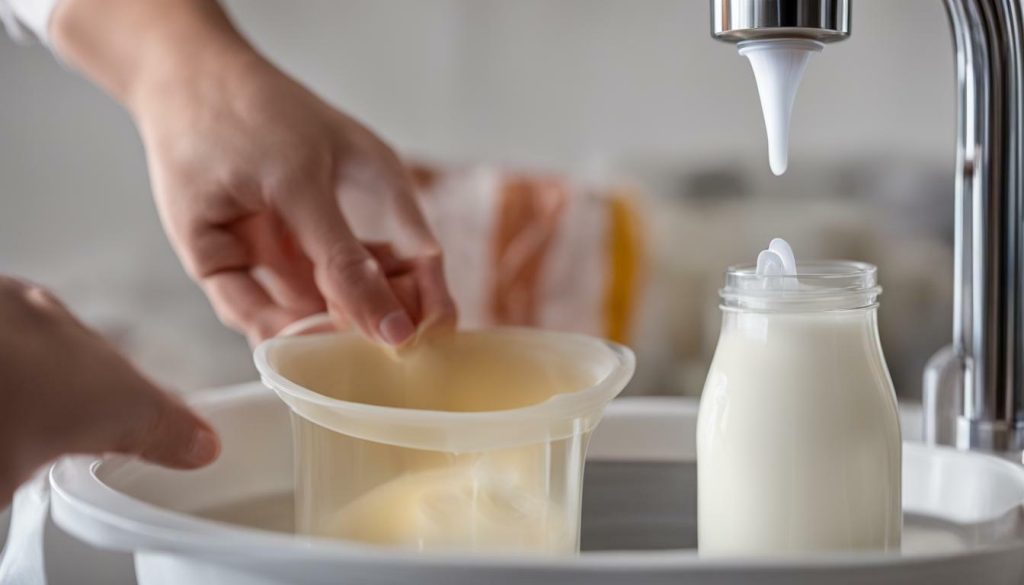
Remember, breast milk can be stored in the refrigerator for up to 5 days and in the freezer for up to one year. It’s generally recommended to only reheat breast milk once or twice, and any leftover milk should be used within 2 hours if it has been warmed. Thawed breast milk should not be refrozen, as it can diminish the quality and safety of the milk.
Before feeding the reheated breast milk to your baby, always check the temperature by shaking a few drops on your wrist. The milk should feel comfortably warm, not hot. This simple step ensures that your baby is not exposed to temperature extremes that could harm their delicate mouth and throat.
In addition to feeding, breast milk can also be used for other purposes. It can be added to bathwater to soothe dry skin or irritations, used as a natural remedy for minor cuts and scrapes, or even turned into personalized jewelry as a keepsake. Breast milk’s unique properties make it a versatile resource beyond feeding.
References:
- Academy of Breastfeeding Medicine. (2020). ABM Clinical Protocol #8: Human Milk Storage Information for Home Use for Full-Term Infants, Revised 2017. Breastfeeding Medicine, 15(9), 569-579.
- Centers for Disease Control and Prevention. (2020). Proper Handling and Storage of Human Milk. Retrieved from https://www.cdc.gov/breastfeeding/recommendations/handling_breastmilk.htm
Stovetop and Warm Water: Safe Methods for Reheating Breast Milk
Reheating breast milk using the stovetop or warm water can be done safely, and in this section, we will discuss the best practices to follow. It is important to remember that breast milk should never be heated directly on the stovetop or in the microwave, as this can lead to uneven heating and destroy valuable nutrients. Instead, opt for gentle warming methods to preserve the quality of the milk.
When using the stovetop, fill a small pot with water and place the bottle of breast milk in it, ensuring that the water level is below the top of the bottle. Heat the water on low to medium heat, stirring occasionally to distribute the heat evenly. Avoid overheating the milk by testing the temperature on the inside of your wrist before feeding it to your baby. The milk should be warm, not hot, to avoid any risk of scalding.
Another safe method for reheating breast milk is using warm water. Fill a clean container, such as a bowl or basin, with warm water. Place the bottle of breast milk in the container and let it sit for a few minutes until it reaches the desired temperature. Gently swirl the bottle to mix any separated cream before feeding. Always check the temperature before serving it to your baby, as it should be comfortably warm to touch.
| Safe Methods for Reheating Breast Milk | Do’s | Don’ts |
|---|---|---|
| Stovetop | Use low to medium heat | Never heat directly on the stovetop |
| Warm Water | Use warm water in a clean container | Avoid using hot water |
Remember, when reheating breast milk, it is important to follow these safe methods and guidelines to ensure the well-being of your baby. Always discard any unused milk that has been warmed for more than 2 hours. By prioritizing safety and best practices, you can confidently provide your baby with the nourishment they need.
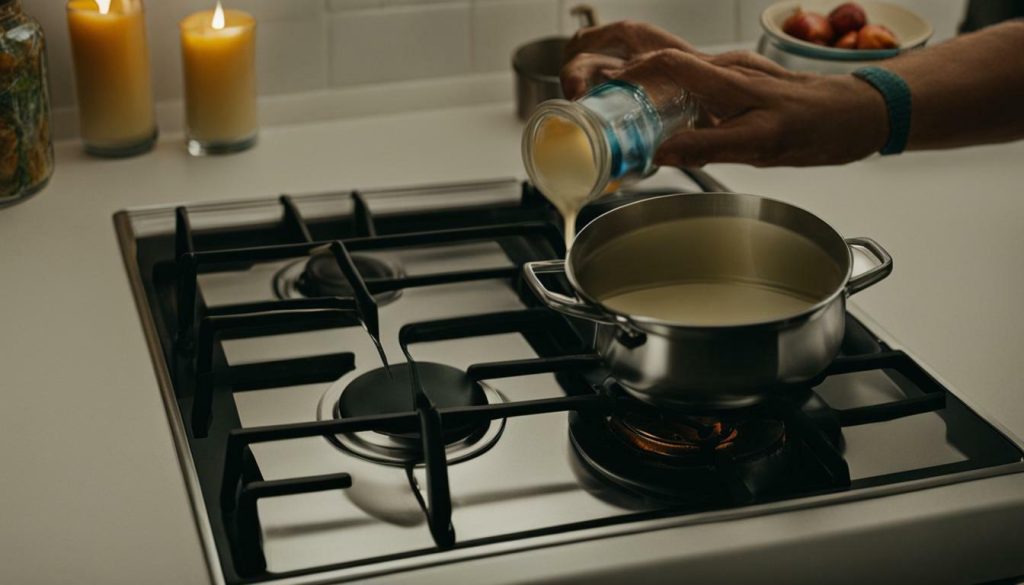
Disclaimer: The information provided in this section is intended for informational purposes only and should not replace professional medical advice. Consult with your healthcare provider for personalized guidance on reheating breast milk.
Avoiding the Microwave: Why It’s Not Recommended for Reheating Breast Milk
While it may be tempting to use the microwave for reheating breast milk, it is not recommended due to potential risks. Let’s explore why and learn about alternative methods.
The main concern with using the microwave to heat breast milk is the uneven distribution of heat. Microwaves heat liquids and food by generating heat from the inside out, which can cause hot spots in the milk. These hot spots can scald your baby’s mouth and throat, leading to burns and discomfort. Additionally, microwaving breast milk can also destroy some of the beneficial properties and nutrients present in the milk.
Instead of using the microwave, it is safer to gently warm breast milk using alternative methods such as the stovetop or warm water. When using the stovetop, place the container with the breast milk in a pot of warm water, making sure not to directly heat the milk on the stovetop. Gradual heating on low heat will help maintain the nutrients and prevent overheating. Another method is to place the container of breast milk in a bowl of warm water, similar to the stovetop method, ensuring that the milk is gently warmed using indirect heat.
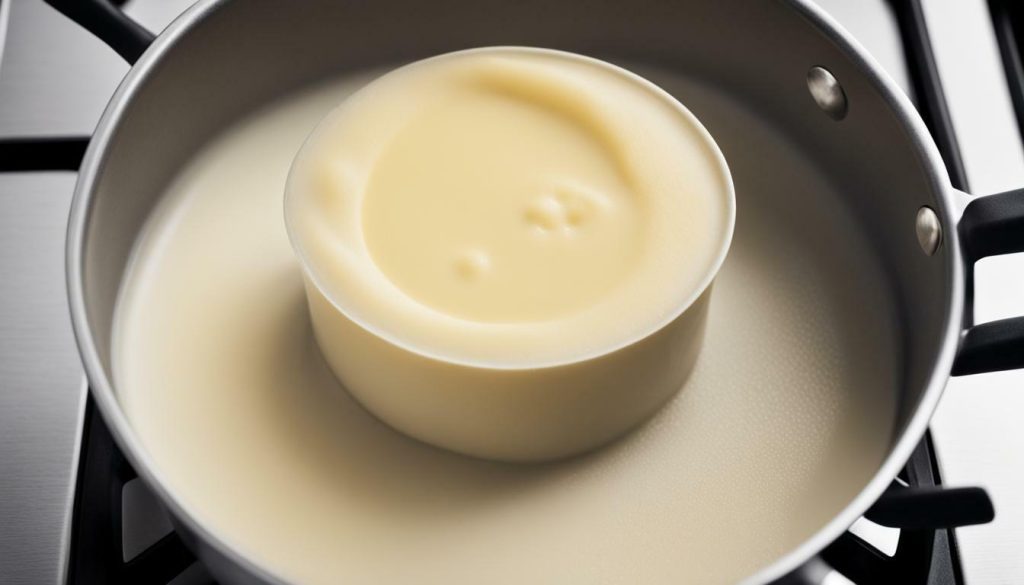
Remember to always swirl the breast milk gently after reheating to redistribute the cream layer, as some of the fat may have separated during heating. To test the temperature, shake a few drops of milk on your wrist to ensure it is comfortably warm before feeding it to your baby. It’s important to follow these safety tips and guidelines to ensure that reheated breast milk remains safe and suitable for your little one’s consumption.
| Safe Methods for Reheating Breast Milk | Unsafe Methods for Reheating Breast Milk |
|---|---|
|
|
By avoiding the microwave and employing safe reheating methods, you can ensure that your baby’s breast milk remains safe, nutritious, and enjoyable for every feeding.
Swirling and Testing: Important Steps before Feeding Reheated Breast Milk
Before feeding reheated breast milk to your baby, there are important steps you should take to ensure its quality and safety. Let’s discuss these guidelines in detail.
After reheating breast milk, it’s crucial to gently swirl the bottle or container. This helps to redistribute the cream layer that may have separated during storage and heating. Swirling the milk ensures that your baby receives the full nutritional benefits of breast milk with each feed.
Furthermore, it’s essential to test the temperature of the reheated milk before offering it to your baby. Avoid relying solely on touch to determine if the milk is at a safe temperature. Instead, shake a few drops of milk onto the inside of your wrist. This area of your skin is sensitive and will give you an accurate indication of the milk’s temperature. The milk should feel comfortably warm, not hot or cold, to ensure your baby’s comfort and safety during feeding.
By following these guidelines of swirling and testing, you can confidently feed your baby reheated breast milk, knowing that you have taken the necessary steps to maintain its quality and safety.
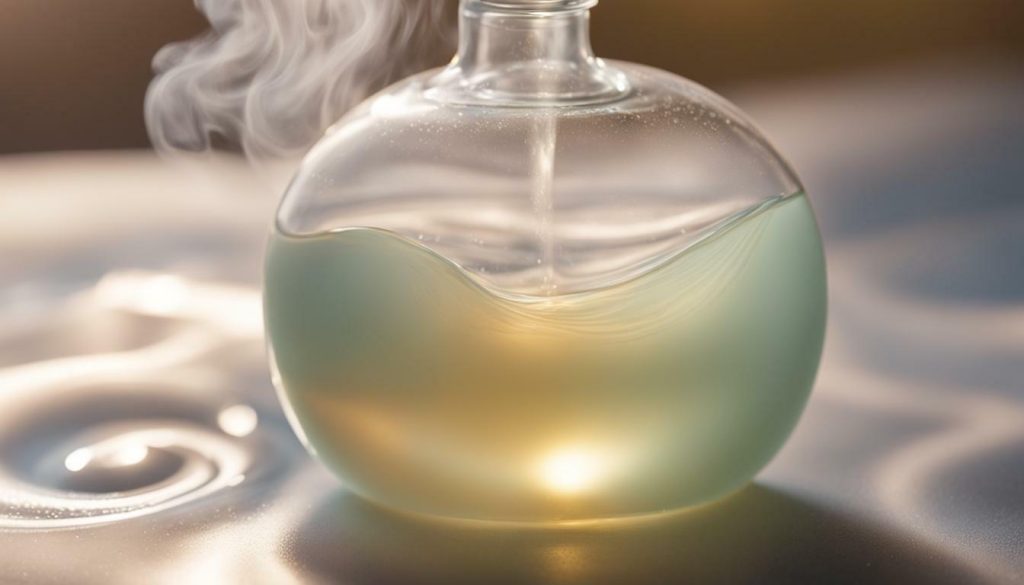
| Guidelines for Reheating Breast Milk | Safety Tips for Reheating Breast Milk |
|---|---|
|
|
Storage Guidelines for Reheated Breast Milk
Proper storage of reheated breast milk is crucial to maintain its freshness and safety. In this section, we will explore the guidelines for storing reheated breast milk.
After reheating breast milk, any leftover milk should be used within 2 hours if it has been warmed. It’s important to discard any milk that has been left at room temperature for longer than that.
Breast milk can be stored in the refrigerator for up to 5 days. It is recommended to use glass or BPA-free plastic bottles with airtight lids to store the milk. Be sure to label each bottle with the date it was expressed and reheated to keep track of its freshness.
If you need to store the breast milk for a longer period, it can be frozen. When freezing, leave some space at the top of the container as the milk expands during freezing. Breast milk can be stored in the freezer for up to one year. It’s important to note that thawed breast milk should not be refrozen.
Table: Storage Guidelines for Reheated Breast Milk
| Storage Method | Storage Duration |
|---|---|
| Refrigerator (4°C/39°F or below) | Up to 5 days |
| Freezer (-18°C/0°F or below) | Up to one year |
Remember to always check the temperature of the milk before feeding it to your baby. Shake a few drops on your wrist to ensure it is at a safe temperature. Proper storage and handling of reheated breast milk will help ensure that your baby receives the best quality milk while minimizing the risk of contamination.
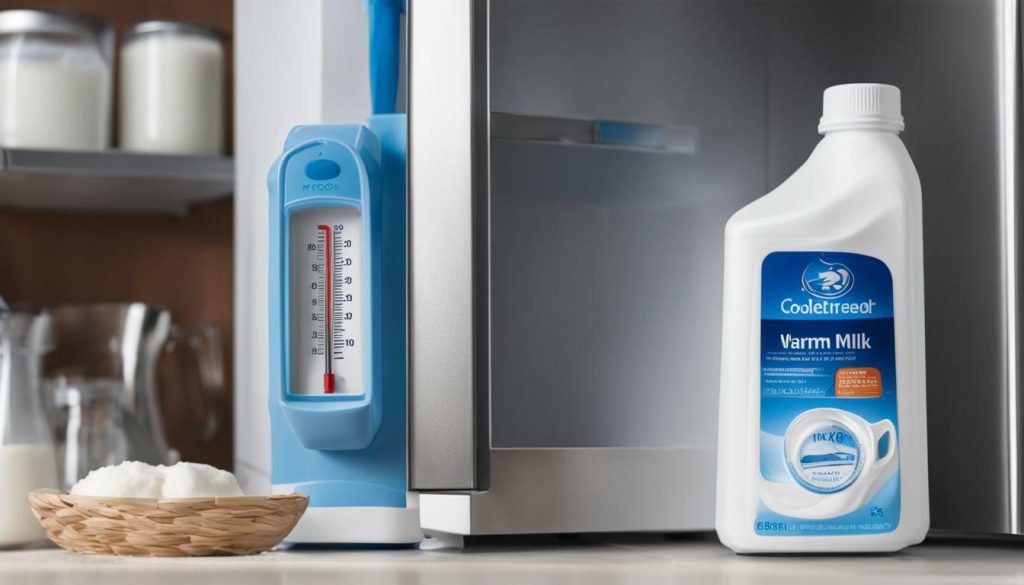
Breast milk can also be used for other purposes beyond feeding. It can be used to soothe skin irritation, added to bathwater for moisturizing effects, or even transformed into personalized jewelry. The natural properties of breast milk make it versatile and beneficial in various ways.
Reheating Breast Milk: Frequency and Leftover Usage
While reheating breast milk is a common practice, there are guidelines to follow regarding its frequency and usage. Let’s delve into these guidelines and tips.
It’s generally recommended to only reheat breast milk once or twice. This is because repeated heating and cooling can degrade the nutritional content of the milk and affect its overall quality. To minimize waste, it’s advisable to heat only the amount of milk that your baby is likely to consume during a feeding. This way, you can avoid having leftover milk that may need to be discarded.
If you have already warmed the breast milk and your baby doesn’t finish the entire bottle, it’s important to use any leftover milk within 2 hours. After this time, bacteria can start to grow, which may pose a risk to your baby’s health. Therefore, it’s crucial to follow these safety guidelines to ensure the well-being of your little one.
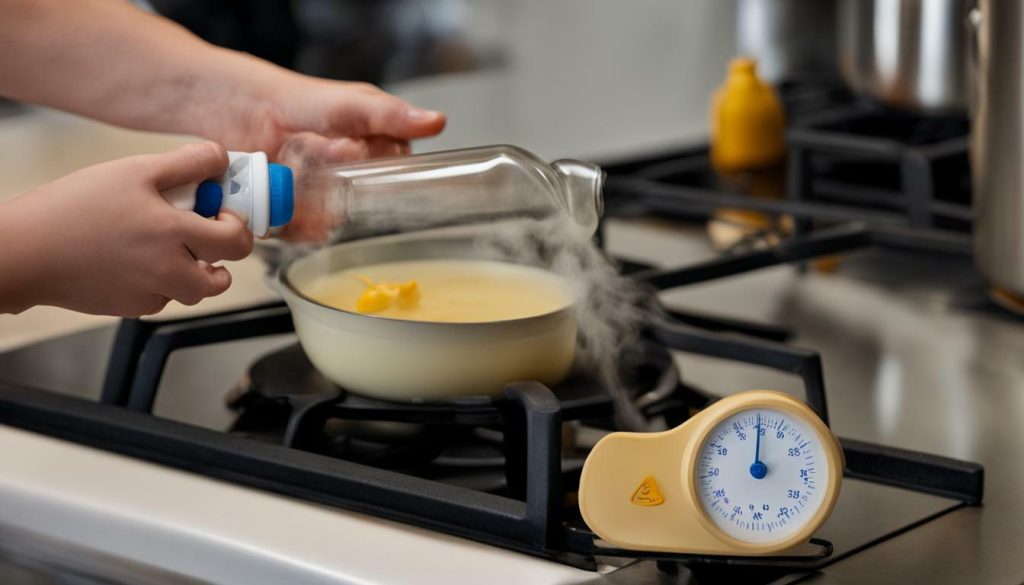
To help you keep track of reheating and usage, here’s a helpful table to refer to:
| Frequency | Guidelines |
|---|---|
| Reheating | Reheat breast milk once or twice maximum to maintain its nutritional value. |
| Leftover Usage | Use any leftover milk within 2 hours if it has been warmed. |
| Thawed Milk | Do not refreeze thawed breast milk; use it within 24 hours. |
By following these guidelines and ensuring proper reheating and usage of breast milk, you can provide your baby with safe and nutritious feedings. Remember to always check the milk’s temperature before feeding by shaking a few drops on your wrist. With these tips in mind, you can confidently navigate the reheating process and ensure your baby receives the best care.
Using Breast Milk for Other Purposes
Breast milk can be more than just food for your baby; it has other beneficial uses as well. Let’s explore the different ways you can utilize breast milk beyond feeding.
1. Soothing skin irritation: Breast milk contains natural antibodies and antimicrobial properties that can help soothe and heal various skin irritations. Simply apply a few drops of breast milk to the affected area and gently massage it in. This can be especially beneficial for diaper rash, eczema, cuts, and scrapes.
2. Adding to bathwater: Breast milk can be added to your baby’s bathwater to moisturize and nourish their delicate skin. It can help soothe dryness and promote a healthy skin barrier. Just add a small amount of breast milk to the bathwater and gently mix it in.
3. Making personalized jewelry: If you’re looking for a unique keepsake, breast milk can be turned into beautiful jewelry. There are artisans who specialize in preserving breast milk and turning it into custom-made rings, pendants, and charms. These pieces serve as a special reminder of your breastfeeding journey and the bond you share with your little one.
Remember, breast milk should always be handled hygienically and stored properly. If you’re considering using breast milk for any purpose other than feeding, make sure to consult with your healthcare provider for personalized advice and guidance.
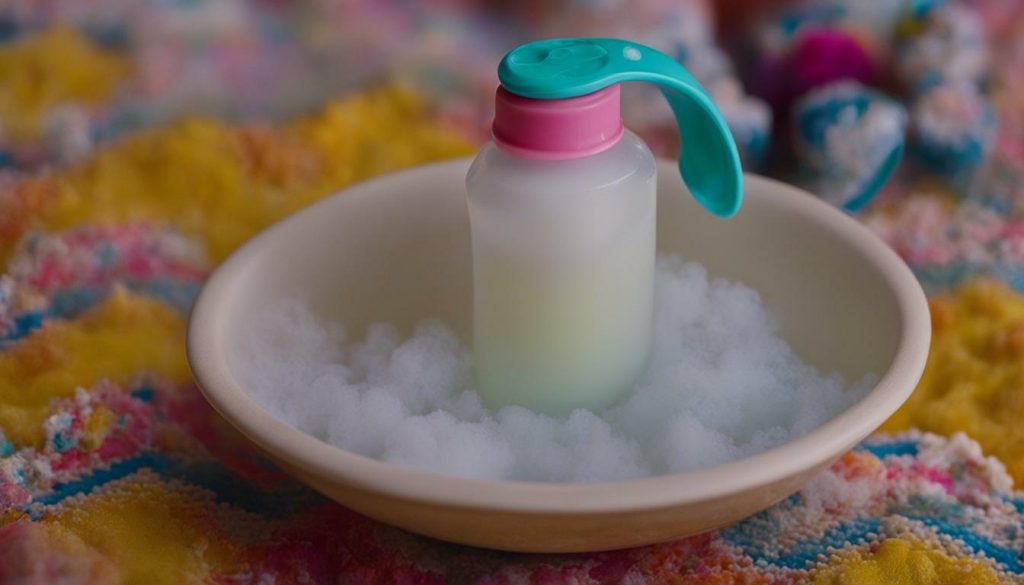
Ensuring the safety of reheated breast milk is of utmost importance. In this section, we will discuss some important safety tips to keep in mind. By following these guidelines, you can ensure that your baby receives high-quality milk that is safe for consumption.
- Thawing: When thawing breast milk, it’s best to do so overnight in the refrigerator or by using cool running water. Avoid using hot water or the microwave, as they can cause uneven heating and destroy essential nutrients.
- Heating Methods: Gently heating breast milk is important to maintain its nutritional value. Use the stovetop or warm running water for reheating. Never heat breast milk directly on the stovetop or in the microwave, as this can create hot spots and decrease its quality.
- Swirling and Testing: Before feeding reheated breast milk to your baby, gently swirl the bottle to redistribute the cream layer. This ensures that the milk is well-mixed and provides a consistent nutrient profile. Always test the temperature of the milk by shaking a few drops on your wrist. It should feel warm, not hot.
Storage: Proper storage is essential for maintaining the quality of reheated breast milk. Refrigerated breast milk can be stored for up to 5 days, while frozen breast milk can be kept for up to one year. Label each container with the date it was expressed to keep track of freshness.
| Storage Guidelines | Refrigerated | Frozen |
|---|---|---|
| Temperature | 40°F (4°C) or below | 0°F (-18°C) or below |
| Duration | Up to 5 days | Up to 1 year |
Using Breast Milk for Other Purposes: Breast milk has many benefits beyond feeding. It can be used to soothe skin irritation, added to bathwater for its moisturizing properties, or even used to create personalized jewelry. Remember to prioritize your baby’s needs before using breast milk for any other purpose.
By following these safety tips and guidelines for reheating breast milk, you can ensure that your baby receives safe and nutritious milk. As a parent, it is important to prioritize the well-being of your child and take the necessary precautions to provide the best care possible.
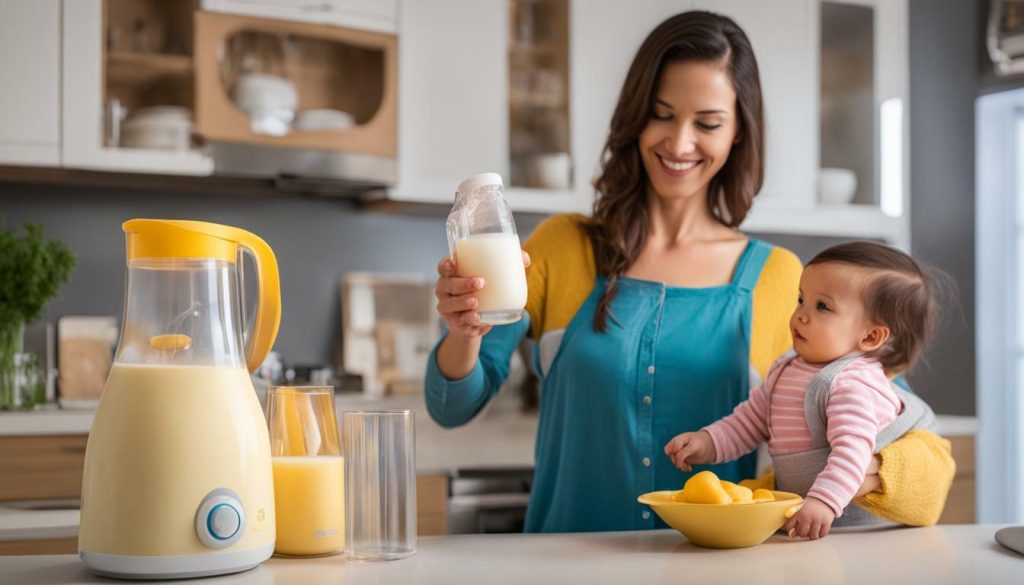
Reheating breast milk can be done safely and effectively by following the guidelines and best practices outlined in this article. It’s important to remember that breast milk is a valuable source of nutrition for your baby, and proper handling and reheating techniques can help maintain its safety and quality.
To thaw breast milk, it is recommended to do so overnight in the refrigerator or by using cool running water. Once thawed, gently heat the milk using either the stovetop or warm running water, as these methods provide even heating without overheating the milk. It’s important to never heat breast milk directly on the stovetop or in the microwave, as this can create hot spots and destroy valuable nutrients.
Before feeding your baby the reheated breast milk, remember to gently swirl the bottle or container to redistribute the cream layer and ensure even consistency. It is also crucial to check the temperature of the milk by shaking a few drops on your wrist. The milk should be warm, but not too hot to avoid scalding your baby.
After reheating, any leftover breast milk should be used within 2 hours if it has been warmed. It’s generally recommended to only reheat breast milk once or twice, as repeated reheating can degrade the quality and increase the risk of bacterial growth. Thawed breast milk should not be refrozen, as this can also compromise its quality.
Aside from feeding, breast milk can also be used for other purposes. It has soothing properties that can help alleviate skin irritation, and it can be added to bathwater for a nourishing soak. Some creative individuals even use breast milk to make personalized jewelry as a sentimental keepsake.
By following these guidelines, you can ensure that your baby receives safe and nourishing breast milk each time it’s reheated. Remember, breast milk is a precious resource, and proper handling and reheating techniques are essential for maintaining its quality and the well-being of your little one.
FAQ
Can you reheat breast milk?
Yes, breast milk can be reheated following proper guidelines to ensure safety and quality.
What are the best practices for reheating breast milk?
Breast milk should be thawed overnight in the refrigerator or using cool running water. It should then be gently heated on the stovetop or using warm running water. Avoid heating it directly on the stovetop or in the microwave.
How do I thaw breast milk and reheat it properly?
Breast milk can be thawed overnight in the refrigerator or by placing the container in cool running water. To reheat, gently warm it on the stovetop or using warm running water. Never heat breast milk directly on the stovetop or in the microwave.
Why is reheating breast milk on the stovetop or using warm water recommended?
Reheating breast milk on the stovetop or using warm water ensures a gradual and even heating process, preserving the nutrients and avoiding the risk of overheating or hot spots.
Can I use the microwave to reheat breast milk?
It is not recommended to reheat breast milk in the microwave as it can create hot spots and destroy valuable nutrients. Alternative methods like using warm water or the stovetop are safer options.
What should I do before feeding reheated breast milk?
Before feeding reheated breast milk, gently swirl the container to redistribute the cream layer. It’s also important to test the temperature by shaking a few drops on the wrist to ensure it’s not too hot for your baby’s mouth.
How long can I store reheated breast milk?
Reheated breast milk can be stored in the refrigerator for up to 5 days and in the freezer for up to one year. It’s important to label and date the containers for proper tracking and usage.
How often can I reheat breast milk and what should I do with leftover milk?
It’s generally recommended to only reheat breast milk once or twice. Leftover milk that has been warmed should be used within 2 hours. Thawed breast milk should not be refrozen.
Can breast milk be used for purposes other than feeding?
Yes, breast milk can be used for soothing skin irritation, adding to bathwater, or even making personalized jewelry. However, it’s important to ensure proper hygiene and safety when using breast milk for these purposes.
What are some additional safety tips for reheating breast milk?
Always make sure to follow guidelines for storing and reheating breast milk properly. Check the temperature before feeding to prevent burns or discomfort for your baby. Avoid refreezing thawed breast milk and discard any leftover milk that has been sitting out for more than 2 hours.




